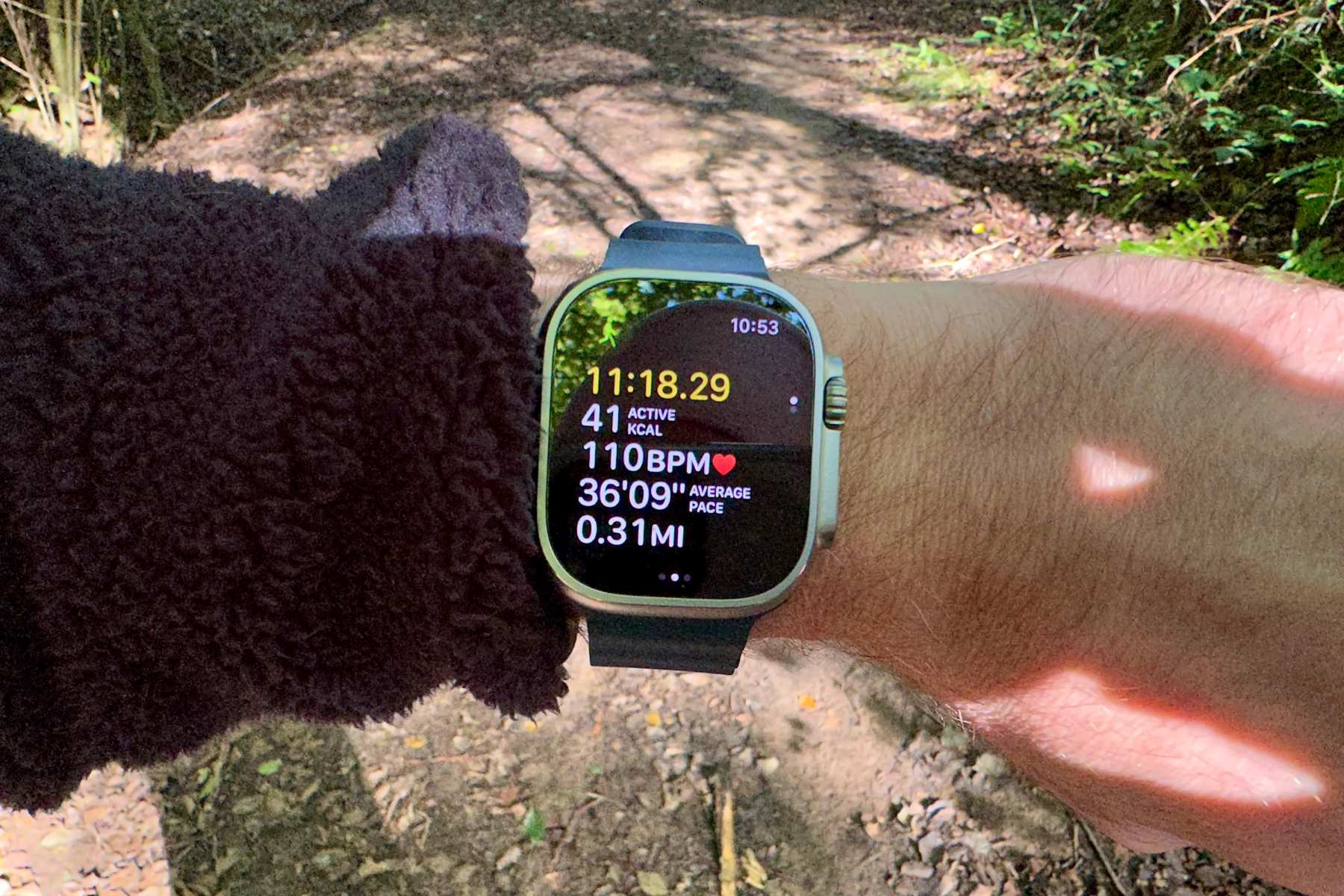

Brands
How To Record Interval Training On Strava
Modified: January 22, 2024
Learn how to record your interval training sessions on Strava with our comprehensive guide. Discover which brands offer the best features and compatibility for accurate tracking.
Introduction
Welcome to the exciting world of interval training! If you’re looking to take your fitness routine to the next level, interval training is a highly effective method to consider. And when it comes to tracking and recording your interval workouts, Strava is the perfect companion.
Interval training involves alternating periods of high-intensity exercise with periods of rest or lower intensity. This type of training has gained popularity for its ability to maximize calorie burn, improve cardiovascular fitness, and enhance athletic performance.
In this article, we will explore the benefits of interval training and how you can use Strava to record and analyze your workouts. Whether you’re a seasoned athlete or just starting your fitness journey, integrating interval training into your routine can help you achieve your goals faster and more efficiently.
Strava is a leading fitness app designed for athletes of all levels. It allows you to track your activities, connect with fellow athletes, and gain valuable insights into your performance. With its user-friendly interface and powerful features, Strava has become a go-to platform for runners, cyclists, and fitness enthusiasts around the world.
By leveraging Strava’s capabilities, you can not only monitor your interval training progress but also gain a deeper understanding of your performance metrics. Whether you’re aiming to set a new personal record or simply want to challenge yourself, Strava can be an invaluable tool to measure and track your interval training workouts.
In the next sections, we’ll dive into the specifics of recording and analyzing interval training on Strava. So, let’s get started and discover how you can make the most out of your interval training sessions with Strava!
What is Interval Training?
Interval training is a method of exercise that involves alternating periods of high-intensity activity with periods of rest or lower intensity. It is a highly effective way to improve fitness, burn calories, and enhance athletic performance. Unlike traditional continuous training, which involves performing a steady-state activity for a prolonged period of time, interval training challenges your body by introducing bursts of intense effort followed by recovery periods.
The concept behind interval training is to push your body outside of its comfort zone, forcing it to adapt and become stronger. By incorporating short bursts of high-intensity exercise, you can elevate your heart rate, build endurance, and increase your overall fitness level.
Interval training can be tailored to various forms of exercise, including running, cycling, swimming, and strength training. For example, a typical interval training workout for running may involve alternating between sprints and jogging or walking. Similarly, a cycling interval workout could consist of alternating between pedaling at maximum effort and cycling at a moderate pace.
One of the key benefits of interval training is that it allows you to achieve more in less time. Compared to longer, steady-state workouts, interval training can provide greater improvements in cardiovascular fitness in a shorter duration. Additionally, the intensity of interval training can increase post-exercise calorie burn, helping you to achieve your weight loss or maintenance goals.
Interval training also offers a variety of physiological benefits. It can improve your oxygen utilization, enhance your body’s ability to clear waste products like lactic acid, and increase your lactate threshold – the point at which your body switches from using oxygen to anaerobic energy production. These adaptations can improve your overall performance in endurance activities and enable you to sustain higher intensity efforts for longer periods.
Whether you’re an athlete looking to improve your performance or an individual seeking a time-efficient workout that delivers results, interval training is an excellent choice. It provides a challenging and versatile training method that can be adapted to suit your fitness level, goals, and preferences.
In the following sections, we’ll explore how you can use the popular fitness app Strava to record and track your interval training workouts in a seamless and effective way.
The Benefits of Interval Training
Interval training offers a wide range of benefits, making it a highly popular and effective method of exercise. Here are some of the key advantages of incorporating interval training into your fitness routine:
- Increased Calorie Burn: Interval training can significantly boost your calorie burn compared to steady-state workouts. The high-intensity intervals require more energy, leading to an increased metabolic rate and continued calorie burn even after your workout is finished.
- Improved Cardiovascular Fitness: By pushing your heart rate to its maximum during the high-intensity intervals, interval training improves your cardiovascular endurance. Over time, this can lead to a stronger heart, increased stroke volume, and improved oxygen delivery to your muscles.
- Enhanced Fat Loss: Interval training has been shown to be highly effective for fat loss. The combination of intense exercise followed by periods of rest or lower intensity can help your body efficiently burn fat for energy.
- Time Efficiency: One of the greatest advantages of interval training is its time efficiency. You can achieve the same or even greater benefits in a shorter duration compared to steady-state workouts. This makes it ideal for those with busy schedules who want to maximize their workout time.
- Increased Endurance: Interval training challenges your body to work at high intensities, which can improve your endurance capacity. The ability to sustain high-effort activities for longer periods is beneficial for sports performance and overall fitness.
- Metabolic Adaptations: Interval training can lead to metabolic adaptations in your body. It can improve insulin sensitivity, increase fat oxidation, and enhance the production of growth hormone, all of which contribute to improved metabolic health.
- Variety and Challenge: Interval training allows for a varied and challenging workout experience. The alternating periods of high-intensity effort and recovery keep your workouts interesting and prevent boredom from setting in.
- Adaptable to Different Fitness Levels: Interval training can be adapted to suit different fitness levels. You can modify the intensity, duration, and ratio of work to rest to ensure it aligns with your current abilities and goals.
With these numerous benefits, it’s no wonder that interval training has gained popularity among fitness enthusiasts and athletes alike. Now that we’ve explored the advantages of interval training, let’s move on to how you can leverage the features of Strava to record and track your interval workouts effectively.
Using Strava for Interval Training
Strava is not just a platform for tracking and sharing your outdoor activities. It also offers a range of features that make it a valuable tool for recording and analyzing your interval training workouts. Here’s how you can use Strava to enhance your interval training experience:
- Data Tracking: Strava allows you to track various data points during your workouts, including distance, pace, heart rate, and power (for cyclists). This data can provide valuable insights into your performance and progress over time.
- Comprehensive Workout History: Strava stores your workout history and allows you to review and analyze it at any time. This feature helps you monitor your improvement, identify trends, and stay motivated.
- Workout Planning: Strava’s interface allows you to plan and create interval workouts in advance. You can specify the duration, intensity, and rest periods, tailoring the workout to your specific needs and goals.
- Community and Social Features: Strava’s social aspect provides a supportive and motivating environment. You can connect with fellow athletes, join groups, and participate in challenges, creating a sense of community and friendly competition.
- Route Exploration: Strava offers a route exploration feature that allows you to discover new routes for your interval training workouts. You can explore popular routes in your area or create your own custom routes to add variety to your training.
- Milestone Tracking: Strava celebrates your milestones and achievements, such as completing a certain distance or setting a personal record. These virtual badges and accolades can be a great source of motivation and satisfaction.
- Training Analytics: Strava provides powerful analytics tools to delve into the details of your interval training workouts. You can examine your heart rate zones, pace graphs, power distribution, and much more, gaining valuable insights into your performance and identifying areas for improvement.
By leveraging these features, Strava can become your go-to platform for capturing, analyzing, and sharing your interval training workouts. The comprehensive data tracking, workout planning capabilities, and social features empower you to stay motivated, set new goals, and monitor your progress along your fitness journey.
Now that you’re familiar with the benefits of interval training and how Strava can enhance your experience, let’s move on to the practical steps of recording your interval training workouts on Strava.
Recording Interval Training Workouts on Strava
Recording your interval training workouts on Strava is a straightforward process that allows you to accurately track your performance and progress. Here are the steps to record your interval training workouts on the Strava app:
- Step 1: Plan Your Interval Training Workout
Before starting your workout on Strava, take a few moments to plan your interval training session. Determine the duration and intensity of your intervals, as well as the rest or recovery periods. Having a clear plan in mind will help you stay focused during your workout. - Step 2: Start Your Workout on Strava
Open the Strava app on your device and navigate to the workout recording screen. Tap on the appropriate activity type, such as running or cycling, depending on your interval training activity. Press the “Start” button to begin recording your workout. - Step 3: Record Your Intervals
During your interval training session, follow your planned intervals and alternate between high-intensity efforts and recovery periods. Strava will record the duration, distance, and other relevant data as you perform each interval. The app will also provide audio cues if you’ve enabled them to help you stay on track. - Step 4: Review and Save Your Workout
Once you’ve completed your interval training session, stop the workout recording on Strava. Take a moment to review the details of your workout, such as the distance covered, average pace, and heart rate data. If everything looks accurate, save your workout to add it to your exercise history on Strava.
By following these simple steps, you can ensure that your interval training workouts are accurately recorded and stored on the Strava app. The app’s easy-to-use interface and reliable tracking capabilities make it a reliable tool for monitoring and analyzing your interval training progress.
Now that you know how to record your interval training workouts on Strava, let’s explore how you can analyze the data and glean insights from your interval training sessions.
Step 1: Plan Your Interval Training Workout
The first step in recording your interval training workout on Strava is to plan your session. Taking the time to plan your intervals and rest periods will ensure that you have a structured and effective workout. Here are some key considerations when planning your interval training workout:
- Define your goals: Determine what you want to achieve with your interval training. Are you looking to improve your speed, endurance, or overall fitness? Setting clear goals will help you structure your workout accordingly.
- Select your intervals: Choose the length and intensity of your intervals based on your fitness level and goals. Shorter intervals with higher intensity are ideal for improving speed and anaerobic capacity, while longer intervals with slightly lower intensity can boost endurance.
- Decide on rest periods: Plan the duration and intensity of your rest or recovery periods between intervals. These periods allow your body to recover and prepare for the next high-intensity effort.
- Determine the number of repetitions: Decide how many intervals you want to perform during your workout. Start with a manageable number and gradually increase as you progress.
- Warm up and cool down: Don’t forget to include a proper warm-up and cool-down in your interval training session. This helps prepare your body for the workout and aids in recovery afterward.
- Consider terrain and conditions: If you’re running or cycling outdoors, take into account factors such as elevation, incline, and weather conditions. Adjust your intervals and intensities accordingly to suit the terrain and outdoor conditions.
Once you have planned your interval training workout, you’ll be better prepared to execute it effectively. Having a clear structure in mind ensures that you can make the most of your workout session and maximize your results.
Now that you have a plan in place, let’s move on to the next step: starting your workout on Strava.
Step 2: Start Your Workout on Strava
Once you have planned your interval training workout, it’s time to start recording your workout on the Strava app. Following these steps will ensure that your interval training session is tracked accurately:
- Open the Strava app: Launch the Strava app on your mobile device. If you don’t have the app installed, you can download it from the App Store or Google Play Store.
- Select the appropriate activity type: From the main screen or the toolbar, choose the activity type that corresponds to your interval training activity. Whether you’re running, cycling, or engaging in any other interval training exercise, Strava offers multiple options to suit your needs.
- Tap the “Start” button: Once you’ve selected the activity type, tap the “Start” button to begin recording your workout. Strava will start tracking your movement, distance, and other relevant data in real-time.
- Secure your device: Ensure that your mobile device is securely attached to your body or equipment. This will prevent any accidental loss or damage during your interval training session.
- Begin your warm-up: Start your interval training session with a proper warm-up. Gradually increase your intensity and prepare your body for the high-intensity intervals to come.
- Execute your intervals and rest periods: Follow the plan you created in Step 1 and alternate between the high-intensity intervals and rest periods. Focus on maintaining proper form and giving your best effort during the intervals.
- Listen to audio cues (optional): If you’ve enabled audio cues in the Strava app, you will receive voice prompts about your pace, distance, or time during your workout. These cues can help you stay on track and keep you motivated.
By following these steps, you can ensure that your interval training session is accurately recorded on Strava. The app’s reliable tracking capabilities will provide you with accurate data about your workout, helping you analyze your performance and progress over time.
Now that you have started your workout on Strava, it’s time to move on to the next step: recording your intervals. We’ll explore this in the next section.
Step 3: Record Your Intervals
Now that you have started your workout on Strava, it’s time to record your intervals during your interval training session. Here’s how you can do that effectively:
- Follow your planned intervals: Stick to the interval plan you created in Step 1. As you progress through your workout, alternate between the high-intensity intervals and the rest or recovery periods.
- Maintain proper form and effort: During your high-intensity intervals, give it your all and aim to maintain good form. Focus on proper technique and make sure you’re pushing yourself to the appropriate level of intensity for each interval.
- Pay attention to your pacing: Strava provides real-time data about your pace, heart rate, and other metrics that can help you gauge your performance. Use this information to monitor your pacing during each interval and adjust accordingly.
- Listen to audio cues (optional): If you’ve enabled audio cues in the Strava app, you will receive voice prompts about your performance. These cues can help you stay on track and provide feedback on your progress during the intervals.
- Stay focused and motivated: Interval training can be challenging, but it’s important to stay focused and motivated throughout your session. Remind yourself of your goals and the benefits of interval training to keep pushing through each interval.
By following these steps, you can ensure that your intervals are accurately recorded on Strava. Recording your intervals with precision allows you to analyze your performance and progress over time, identifying areas for improvement and celebrating your achievements.
Now that you’ve successfully recorded your intervals, let’s move on to the final step: reviewing and saving your workout on Strava.
Step 4: Review and Save Your Workout
After completing your interval training session and recording the intervals on Strava, it’s time to review and save your workout. Follow these steps to ensure your workout data is accurately saved:
- Stop the workout recording: Once you’ve completed your interval training session, stop the workout recording on the Strava app. Tap the “Stop” or “Finish” button to end the recording. This will finalize the data collection for your workout.
- Review your workout details: Take a moment to review the details of your workout. Strava will display information such as total distance covered, average pace, elevation gain, and other relevant data. Ensure that this information aligns with your performance during the interval training session.
- Check for any discrepancies: If you notice any discrepancies or inaccuracies in the data, you can edit or adjust the details manually using the editing features provided by Strava. This will ensure that your workout data is as accurate as possible.
- Add additional information (optional): If desired, you can add additional information about your workout. Strava allows you to include notes, tag friends who participated with you, or add any other relevant details that you want to remember about your interval training session.
- Save your workout: Once you’re satisfied with the accuracy and completeness of your workout data, save your session on Strava. This will ensure that your interval training workout is added to your exercise history and can be accessed for future reference and analysis.
By following these steps, you can confidently review and save your interval training workout on Strava. The app’s comprehensive tracking and reviewing features allow you to analyze your performance, monitor your progress, and celebrate your achievements.
Now that you have successfully reviewed and saved your workout, you can explore the analytics and insights provided by Strava to gain a deeper understanding of your interval training progress. We’ll delve into this in the next section.
Analyzing Interval Training Data on Strava
Once you have recorded and saved your interval training workouts on Strava, you can leverage the app’s powerful analytics tools to gain valuable insights into your performance. Here’s how you can analyze your interval training data on Strava:
- Workout summaries: Strava provides detailed workout summaries for each interval training session. These summaries include metrics such as total distance, average pace, elevation gain, and average heart rate. Reviewing these summaries allows you to track your progress and compare your performance across different workouts.
- Segment exploration: Strava allows you to explore specific segments of your interval training workouts. Segments are portions of your route that have been marked by other Strava users as designated segments. By analyzing segment data, you can monitor your performance against other athletes and track your improvement over time.
- Heart rate analysis: If you’ve recorded your heart rate during your interval training sessions, Strava’s analytics tools allow you to examine your heart rate data in detail. You can analyze your heart rate zones, identify trends, and determine the effectiveness of your training intensity levels.
- Pace and speed analysis: Strava provides graphs and charts that display your pace or speed during your interval training workouts. Analyzing these metrics can help you identify patterns, analyze pacing strategies, and optimize your performance for future workouts.
- Power analysis (for cyclists): If you’re a cyclist and use a power meter during your interval training sessions, Strava can provide detailed power analysis. You can examine your power output, power zones, and power distribution throughout your workout, gaining valuable insights into your cycling performance.
- Training load and fitness analysis: Strava calculates training load and fitness metrics based on your interval training workouts. These metrics give you an indication of your overall fitness level, training progress, and how well you’re adapting to your interval training sessions.
- Comparisons and PR tracking: Strava allows you to compare your interval training workouts to previous sessions or to specific time frames. You can track your personal records (PRs), set new goals, and benchmark your progress against yourself and other athletes.
By utilizing these analytics tools on Strava, you can gain valuable insights into your interval training performance. Analyzing your data allows you to identify strengths, pinpoint areas for improvement, and make informed decisions about your training plan.
Now that you’re equipped with the knowledge of how to analyze your interval training data on Strava, you can make the most of your interval training sessions and continually improve your performance.
Conclusion
Interval training is a highly effective method to elevate your fitness routine and achieve your fitness goals. By incorporating periods of intense exercise followed by rest or lower intensity, interval training helps improve cardiovascular fitness, burn calories, and boost overall athletic performance.
When it comes to tracking and recording your interval training workouts, Strava stands out as a valuable tool. With its user-friendly interface and powerful analytics features, Strava allows you to accurately monitor your interval training progress and gain valuable insights into your performance metrics.
By following the steps outlined in this article, you can effectively record your interval training workouts on Strava. Plan your intervals, start your workout on the app, record your intervals with precision, and review and save your workout data. Furthermore, Strava’s analytics tools enable you to analyze your interval training data, track your progress over time, and make informed decisions about your training plan.
Whether you’re a seasoned athlete or just starting your fitness journey, integrating interval training into your routine can help take your fitness to new heights. With Strava as your training companion, you can push your limits, track your progress, and achieve your fitness goals with confidence.
So, lace up your shoes, hop on your bike, or hit the gym, and let Strava be your guide to recording and improving your interval training workouts. Start today and unlock your full potential!



